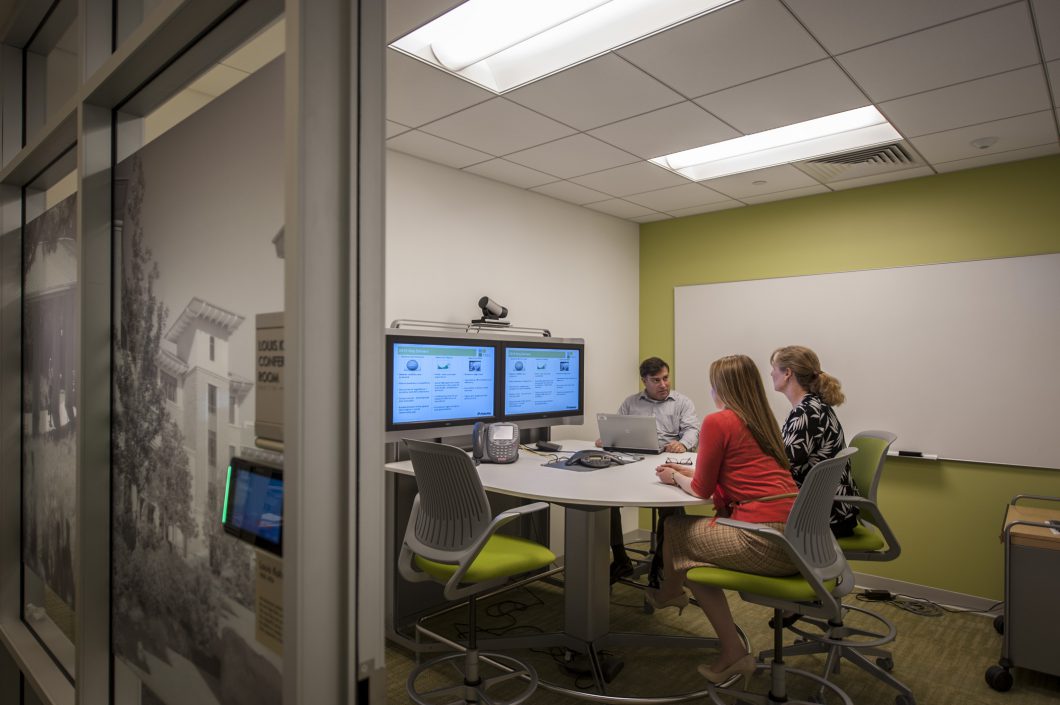
Stop Designing Your Workplace Around Millennials
Stop thinking about millennials when designing your workplace. Here’s what to think about instead.

Fidelity Go Work – FREC Center | Summer Street, Boston Conference Room
Research shows flexible workplaces that follow a lifespan of your employees are more important.
All too often, executives look at their office design and workplace environment with a narrow focus. Millennials. Millennials. Millennials.
They will be the next generation of workers when boomers retire, right? They will be the ones that will drive your growth, and they think differently than previous cohorts of employees. Indeed, by 2020, they will account for half of the workforce.
But designing your office around their present day needs is short-sighted.
Look beyond the gourmet cafeterias and free massages, the giant slides and foosball tables. While these design ideas can aid in recruiting, retaining, engaging, and empowering your employees, they emphasize younger workers.
Demographers like to uncover, classify, and name groups: Baby Boomers, Generation X, Millennials. It’s what they do. But it’s not what corporate real estate, human resources, and workplace designers do. We deal with living, breathing, changing organisms called organizations—made up of all kinds of individuals, juggling all kinds of life events, needs, and desires.
A generational focus can obscure the fact that employees have lives, and life experiences influence how people engage at work. The “perfect” workplace would understand this and be able to recognize, via sensors and other technology, how employees are interacting with their environment. The workplace will then evolve to meet employee needs in close-to real time.
We’re not there yet.
A life stage approach
But we do know that employees at certain stages of life have typical requirements and expectations of work, and face predictable work and life challenges. Some of the more obvious are single employees who want ways to socialize at and after work, or new mothers who have specific needs such as mother’s rooms. And, these life stages do not necessarily align with arbitrary generational groupings.

It’s also important to remember that life stages don’t have to be a linear progression. As Merck & Co.’s workplace strategist Adrienne Rowe points out, some parents of grown children may have grandchildren living in the home. They may have the needs of older employees closing in on retirement as well as a young family. The challenge for a truly successful life stage approach to workplace design is dedicating the necessary resources to identify and understand the typical life stages that exist uniquely in each organization.
So what does that mean for workplace design?
If we focus on employees according to their life stages, not their generations, what are the consequences for workplace design? First, flexibility and choice move to the forefront. Environmental versatility is key if you’re trying to create spaces that engage and empower people who are focused on everything from self-definition to balancing commitments (work, family, community) to workplace stability.
Versatility doesn’t just mean providing different types of workstations and meeting spaces with various furniture configurations. It’s a business strategy that must be integrated across human resources, information technology, and operations.
Still, no matter how much we stress the importance of thinking about life stages, millennials will still be a concern for my clients. Yet my firm and the University of Cincinnati conducted research to characterize millennials, and what struck us most was not how different they are from previous generations of young people entering the workforce but how similar they are. They seek fulfillment at work, connection to a greater good, and a sense of community and collaboration, just as their parents did at that stage in life. Millennials may be more passionate and outspoken about these values, but that’s a difference of quantity, not of kind.
As Merck’s Rowe says, “With respect to designing spaces and amenities in the workplace, we observe that most individuals have the same essential priorities. They want places to collaborate, focus and socialize with colleagues. Flexibility and autonomy are universally important. Everyone loves an airy, naturally lit environment. They all want to learn, adapt and perform their best work.”
Best strategies for investing in workplace design
Generational definitions can get in the way of this commonality. Our research backs this up, showing how your smartest investment will be to create strategies and environments that do the following:
- First, meet the full spectrum of employees’ needs across all generations and life stages. That means everyone—from the young singles craving opportunities to socialize and collaborate and the middle-aged workers balancing family and maturing careers, to the elder knowledge-bearers with an eye on retirement.
- Second, honor core human desires, such as having a strong purpose, clear goals and meaningful work. This means acknowledging and promoting specific talents and rewarding performance, not just long hours at a desk.
- Third, make sure your workplace evolves over time, just as workers’ professional and personal lives evolve. Plan for singles who crave socializing, for the new nursing mothers, and for the seniors who value mentorship.

I often caution my clients at BHDP Architecture to worry less about gourmet cafeterias, in-house massages and design-your-own workstations. Because what truly matters most to workers is universal, no matter the generation.
Originally published in Out of Office.
